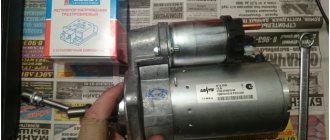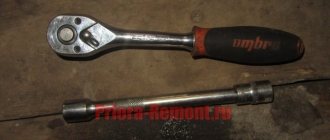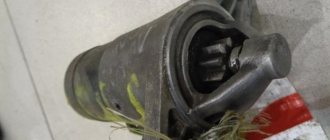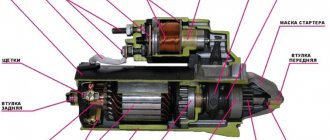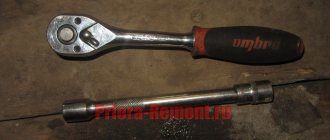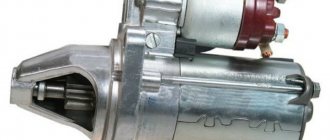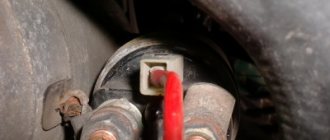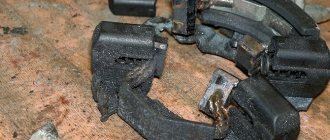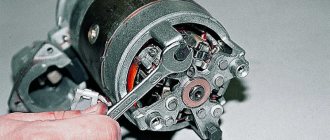Starter for Daewoo Nexia
Analogue produced by .
The basic design of the starter has remained virtually unchanged throughout the production of the car - it is a 4-pole electric motor with 4 DC brushes, combined with a solenoid electromagnetic relay.
8 valves
On 8-valve engines of early years of production, starters were installed without a planetary gearbox, and therefore less power.
In good weather conditions, the difference in performance between the two starters was practically not felt, but as soon as frost hit, the old starters for eight-valve engines could barely cope with their work.
Their power (for example, Delta autotechnik A17120 ) ranged from 0.7 to 0.9 kW .
16 valves
Starters for 16-valve 1.6-liter engines began to be equipped with a planetary gearbox and, accordingly, the electric motor power increased to 1.3 kW.
This affected both the torque of the electric motor and its ability to start a larger engine even in cold weather. For example, EAI 11510 already produced 1.4 kW. Also on sale you can find 1.2 kW units with a planetary gearbox from Achim with catalog number 96469963 made in Korea.
Their price is about 4 thousand rubles.
What is the difference?
On the left is an old starter without a gearbox, on the right is a new starter with a planetary gearbox.
Visually, they differ from starters for a 1.5-liter eight-valve engine by the presence of studs for mounting the planetary gearbox . Otherwise, the process of dismantling the old and new starters is no different, as we will now see.
Removing the starter for Daewoo Nexia
A little trick: it’s more convenient to unscrew the starter mounting bolt from above using short keys.
Regardless of the starter model, the process of dismantling it is practically the same.
This happens as follows:
- It is more convenient to carry out the work on an inspection hole or overpass. We install the car and secure it with the parking brake.
- First of all, we remove the negative terminal from the battery, thereby de-energizing the electrical system.
- Turn off the starter power.
To do this, use a 13mm head to unscrew the nut securing the positive terminal on the starter. Unscrew the fixing nut of the “positive” tip. - We remove the terminal.
- Using a 10mm socket, unscrew the nuts securing the control wire terminals on the solenoid relay and remove the wires from the terminals.
Unscrew the nut of the “control” wire. - Now disconnect the starter ground wire. It is screwed to the upper stud securing the starter to the clutch housing and for this we use a 13mm socket with an extension wrench.
From below, the ground tip nut is almost invisible. It is easier to unscrew from the top with a short 13mm wrench. - Unscrew the two bolts securing the starter to the clutch housing.
Unscrew the lower starter mounting bolt. - We remove the starter from its seat.
After removing the starter, we also check the condition of the flywheel teeth.
Conclusion
We diagnose, replace or repair the starter, and install the unit in place in the reverse order. Good luck to everyone and start the engine with a half turn.
Before installation, clean the terminals. Lubricate the tips with lithol to prevent corrosion.
Video on how to independently check the performance of the starter
Source: https://carfrance.ru/snimaem-starter-na-daewoo-nexia/
Daewoo Nexia starter repair in Moscow auto repair shops
35 car repair companies
- TTS Motors
- Pyatnitskoe highway, 2
- +7 (495) 24… show all
- The site of the company
- Lorant
- Wilgood
- Garimotors
- Lexus on the market
- Auto-rad
- Wilgood
- Wilgood
- Wilgood
- Wilgood
- Wilgood
- Wilgood
Popular companies
Removing the starter on a Daewoo Nexia 2008 car
We carry out the work on an inspection ditch or overpass. Disconnect the negative cable terminal from the battery terminal.
Using a 13mm socket, unscrew the nut securing the tip of the starter positive wire...
...and disconnect the wire tip.
Using a 10mm socket, unscrew the nut securing the tip of the traction relay control wire...
...and disconnect the wire tip . Using a “13” socket with an extension, unscrew the nut securing the tip of the “mass” wire to the special bolt of the upper fastening of the starter and disconnect the tip of the wire.
Using a “13” socket with an extension, we unscrew the two special bolts securing the starter... ...and, moving the starter, remove it from the hole in the cylinder block.
Removing the starter.
Use a screwdriver to turn the drive gear . The gear should only rotate in one direction. Otherwise, replace the drive with a new one.
Use a screwdriver to move the drive gear with the freewheel on the starter shaft . The gear should move easily on the shaft splines.
We connect the positive terminal of the battery with the control terminal of the traction relay with wires for “lighting”, and the negative terminal with the “ground” (starter housing) . In this case, the anchor of the traction relay should push the gear with the overrunning clutch into the window of the front cover. A faulty traction relay must be replaced.
We connect the positive terminal of the battery to the lower contact bolt of the traction relay, and the negative terminal to ground . In this case, the rotation speed of the starter armature should be 2800-3000 min-1 with a voltage at the wire terminals of 11.5-12.0 V. Otherwise, repair of the starter is necessary. ( 6
Source: https://daewoo.biz/remont-daewoo/nexia-2008/remont-avtomobilya/elektrooborudovanie/starter/snyatie-startera/
Required Tools
To replace the starter on a Nexia, you need a list of tools, which is presented in the table below.
Table - Tools required to replace the front strut
| Name | Note |
| Head | "at 10", "at 13" |
| Extension | Preferably with a ratchet |
| Short open-end wrench | "at 10", "at 13" |
| Screwdriver | With cross and flat blade |
| Socket wrench | “at 7”, “at 8”, “at 10”, “at 13”, “at 15” |
| Rags | To clean dirt |
To remove and install the starter, access is required from the bottom of the vehicle. Therefore, when carrying out operations, it is important to have an inspection hole, overpass or lift.
How to remove the starter on a Daewoo Nexia? Replacing the bendix and solenoid relay
The service life of the Daewoo Nexia is around 100,000 (km) mileage .
A starter with a planetary gearbox (rated power 1.2-1.4 kW) is more reliable . This starter was equipped with 16-valve models . The Daewoo Nexia with 8 valves was supplied with a gearless starter (rated power 0.7-0.9 kW).
It is worth noting that the Daewoo Nexia maintenance regulations provide for the repair of the starter unit by replacing a worn starter with a completely new analogue .
But the price of the simplest starter is around $50 . And for many drivers there is no other choice but to carry out major repairs of the starter .
In this way you can reduce the financial costs of repairs up to 10 times !
The weak points of the Daewoo Nexia starter unit are the bendix (drive gear) and the solenoid relay . In this review, we will look at how to dismantle the starter and replace the above-mentioned components .
The process of removing and repairing the starter
- The master cannot do without an overpass or inspection hole. We drive the car into a pit/overpass, turn off the vehicle and apply handbrake lever
- Open the hood and remove the negative terminal from the battery .
- We look under the car and unscrew the engine protection (if provided).
- We find the starter unit , it is located on the gearbox .
- We unscrew the fastening of the positive terminal on the starter and fold the wire to the side. This way we de-energize the starter unit.
- Remove the solenoid relay control wires . You need to unscrew the nuts (2 pcs) and move the wiring to the side.
- Disconnect the starter ground wire . It is secured with a nut on the stud securing housing to the mounting site on the gearbox.
- We unscrew the fasteners of the starter housing to the mounting pad on the gearbox. The starter is held in place by 1 bolt and 1 locked pin.
At this stage, you can also inspect the gearing on the flywheel..
Starter unit repair
It is worth noting that the bendix and the solenoid relay are far from the only possible causes of starter failure . The starter assembly is still subject to wear: brushes, rotor, stator, bushings .
Before repairing the starter, it is imperative and absolutely necessary to carry out a comprehensive diagnosis of the starter assembly . This work can only be carried out efficiently by a highly qualified specialist who is specifically engaged in repairing starters.
Replacing the retractor and bendix is carried out in the following order:
- Remove the power wire of the solenoid relay . It is secured with a nut.
- Unscrew the fasteners of the solenoid relay . You need to remove 3 screws (or on some modifications 2 bolts ).
- Removing the solenoid relay.
- Remove the outer starter cover . It is held in place by 2 tightening bolts and 1 fastener with a TORX E5 (E7) head. On the Nexia there are no 16 valves with tightening bolts, instead there are 3 ordinary bolts (they secure the planetary gear housing).
- We remove the solenoid relay plug from the Bendix . The fork is secured with a pin.
- Use a puller to remove the locking ring .
- simply take out the worn bendix and put a new one in its place .
- We assemble the unit in the reverse order.
- When installing a retractor relay, we install a completely new retractor instead of a worn one.
- We put the starter in place.
- We do a test drive.
What was used in the renovation process?
- Set of keys (with TORX head E5 (E7))
- Screwdriver Set
- Retaining Ring Puller
- Multi-measurement tool
New components will also be needed, such as a bendix and a solenoid relay.
What was used in the renovation process?
- Set of keys (with TORX head E5 (E7))
- Screwdriver Set
- Retaining Ring Puller
- Multi-measurement tool
New components will also be needed, such as a bendix and a solenoid relay.
Additional information
A malfunction of the retractor relay is indicated by the absence of a characteristic click when the ignition key is turned to the “starter” position.
A malfunction of the bendix may be indicated by the absence of rotation of the flywheel when the starter is turned on . Most often the fork breaks off. But it is customary to change the Bendix along with it, since its gear wears out over time, and the Bendix body itself becomes filled with abrasive.
Source: zaz-shop.com.ua
Replacing the Nexia starter: instructions, photos, videos, description
The starter in a car is designed to start the engine. A short-term charge is supplied from the ABC to the starter, which in turn rotates the flywheel at high speed.
The Daewoo Nexia starter is reliable, although it has its own resource, so it also requires maintenance and repair.
In the article we will talk about the causes of the malfunction, selection of a starter and replacement and repair procedures, as well as the manufacturer’s recommendations.
Video
The video will tell you how to replace the starter on Nexia
Starter replacement
Replacing a starter is quite a difficult procedure, especially for those who have never done it before. But don’t worry, it will seem easy enough. Let's move on to the replacement process itself.
- We dismantle the motor protection.
The master cannot do without an overpass or inspection hole. We drive the car into a pit/overpass, turn off the vehicle and apply the handbrake lever. Open the hood and remove the negative terminal from the battery.
- Unscrew the power cable nut.
We look under the car and unscrew the engine protection (if provided).
- Disconnect the contact relay.
We find the starter unit, it is located on the gearbox assembly site.
- Unscrew the traction relay.
We unscrew the fastening of the positive terminal on the starter and fold the wire to the side. This way we de-energize the starter unit. - We remove the wire.
Remove the solenoid relay control wires. You need to unscrew the nuts (2 pcs) and move the wiring to the side.
- Unscrew the mass nut and remove it.
Disconnect the starter ground wire. It is secured with a nut on the stud securing the starter housing to the mounting site on the gearbox.
- Unscrew the starter mount.
We unscrew the fasteners of the starter housing to the mounting pad on the gearbox. The starter is held in place by 1 bolt and 1 locked pin.
- We dismantle the starter.
We get the starter. At this stage, you can also inspect the gearing on the flywheel. It is worth noting that the bendix and the solenoid relay are far from the only possible causes of starter failure.
The starter assembly is still subject to wear: brushes, rotor, stator, bushings. Before repairing the starter, it is imperative and absolutely necessary to carry out a comprehensive diagnosis of the starter assembly.
This work can only be carried out efficiently by a highly qualified specialist who is specifically engaged in repairing starters.
- Now, you can either repair it or replace it with a new one.
Starter selection
96208781 - original catalog numbers of the Daewoo Nexia starter manufactured by Daewoo with a cost of 10,000 rubles. In addition, there are a number of analogues that can be used:
Starter.
| Name | vendor code | Price |
| Magneti marelli | 943205191010 | 4000 |
| Nipparts | J5210905 | 5000 |
| Mando | EX96952005 | 7000 |
| Fenox | ST31123 | 7000 |
| Valeo | 438183 | 8000 |
| Valeo | 838026 | 10000 |
| Bosch | 0 986 014 860 | 10000 |
Causes of starter malfunctions
Before you begin the repair or replacement process, you need to know the reasons for the unit malfunction. They are quite familiar to many car enthusiasts. There are quite a few reasons for the Daewoo Nexia starter not working, but let’s look at the main ones:
- The battery does not work;
- terminal oxidation;
- traction relay closing;
- open circuit of the traction relay;
- inoperability of contact ignition;
- anchor jams;
- wear and sticking of brushes;
- ignition circuit break;
- clutch is faulty;
- drive gear wear;
- the gear does not fit on the flywheel teeth;
- armature bearing wear.
These are some of the reasons for the impossibility of starting the starter, and therefore the engine.
Conclusion
Considering everything that has been said, it is worth emphasizing that repairing the Daewoo Nexia starter is not that difficult and can be done with your own hands without any problems. But if it needs to be replaced, it is worth paying attention to the fact that the selection should be carried out by determining the catalog number, which can be found on the starter itself or using online catalogs.
Source: https://koreanautoreview.com/daewoo/nexia/zamena-startera-neksiya.html
Replacement
The Daewoo Nexia starter is located on the gearbox mounting area. Before dismantling, the following tools are prepared:
- ratchet with extension;
- heads 10, 11, 13;
- wrenches 10, 11 and 13;
- flat and figured screwdrivers;
- curved socket wrench – 7, 8, 10, 15;
- clean rag.
Replacement is carried out in the following sequence:
- drive the car onto a viewing hole or overpass;
- apply the parking brake, open the hood;
- disconnect the negative terminal from the battery;
- dismantle the engine protection;
- unscrew the nut of the control power wire;
- unscrew the positive terminal from the starter, take the wire to the side;
- remove the traction control wires by unscrewing two nuts from the top and output bolts;
- disconnect the starter ground wire - it is attached to a separate stud on the mounting platform;
- Using a ratchet, unscrew the mounting bolt and the locked starter pin;
- get the starting device;
- install new.
Daewoo Nexia 1.5 replacing starter retractor relay, photo and video instructions
We have a Daewoo Nexia car under repair, produced in 2001, with a 1.5 liter engine, mileage 368 thousand km, we need to replace the solenoid relay here. We'll show you how to do it yourself, as quickly and correctly as possible.
The engine on this car was replaced, after the replacement the retractor refused to work normally, until you hit it with something, it does not work. Open the hood and disconnect the negative terminal from the battery. It is most convenient for us to carry out the work from below, so we lift the car.
Here is the starter that needs to be removed there:
It is secured with two bolts, under a 13 socket. Two wires come to it, positive (unscrewed with a 13 socket) and excitation (unscrewed with a 10 socket). We dismantle it and begin disassembling, unscrew the nut:
Unscrew 3 screws on the case:
We have new solenoid relays from PMC, order number PXPECB-002. On the new retractor we need to remove the plug, since it will be inconvenient to tighten it, this can be done using pliers:
We screw the new solenoid relay to the starter. During assembly, an unpleasant detail came to light, but the Partsmall retractor was not threaded! This is a warranty case, you can take it straight back to the store, but we didn’t bother and cut it ourselves, and we already managed to break the plug.
After the assembly we install it on the car, put the head on the top stud and start it together. We assemble in reverse order.
Video replacement of the solenoid relay Daewoo Nexia 1.5
Backup video on how to replace the solenoid relay in Daewoo Nexia
Read times: 518; Today: 1
Source: https://remontautohelp.ru/dehu-neksiya-1-5-zamena-vtyagivayushhego-rele-foto-i-video-instrukciya/
How to replace the crankshaft sensor (CPS) on a Nissan Almera N16 in a service station
The need to synchronize the opening and closing of valves with the reciprocating movements of the pistons is probably known to all car owners - even those who recently became the owner of a car.
They also know that this synchronization is ensured by a timing belt or chain, thanks to which the crankshaft and camshaft rotate at perfectly equal speeds.
But few people know that modern cars have a mechanism to control the rotation of these parts, and crankshaft and camshaft sensors perform this function.
Design and principle of operation of crankshaft and camshaft sensors
If the operation of the gas distribution mechanism is, in fact, under double control, then why, when the timing belt (chain) breaks, do the pistons and valves still collide, as a result of which all the parts become unusable? It’s all very simple: a timing transmission failure always occurs unexpectedly, while the shafts rotate at a speed of about 2000 rpm and it is impossible to stop them instantly. Moreover, the shafts are under different loads, so their braking speed is also different. This leads to serious engine damage.
Important: the mechanism for monitoring the synchronism of shaft rotation can ensure the safety of the components of the gas distribution mechanism only if the timing gear is at least partially serviceable. Let us repeat once again: the crankshaft and camshaft sensors only monitor the process of their rotation, and do not ensure their synchronization
The latter is entirely the responsibility of the corresponding belt or chain.
The device that controls the speed of rotation of the camshaft is designed in exactly the same way and also requires replacement if it fails.
When is it necessary to replace the crankshaft sensor on a Nissan Almera N16: signs of malfunction
Symptoms of malfunction of both of these elements are the same and include:
- inability to start the engine - neither by turning the ignition key, nor by push;
- if the part we are considering fails while the car is moving, then the engine begins to operate unstably, which is felt both by its “sneezing” sound and by increased uneven vibration transmitted to the body;
- a sharp decrease in vehicle power;
- there is an equally sharp deterioration in its dynamics: you press the gas pedal almost to the floor, and if the car reacts to this, it is weak.
It's hard to say what could cause these parts to fail. In most cases, this is a manufacturing defect, less often - mechanical damage, resulting in leakage of liquid electrolyte or destruction of the insulation between the liquid and solid components of the part.
Installing a new sensor
On different engines (and Almera has at least five different engines in its range) this operation is performed slightly differently. On some engines, this even requires removing the cylinder head and timing gear, which significantly complicates the procedure. After all, after this you have to set the valves and cylinders in the position corresponding to the beginning of the first stroke of the engine, and also check the accuracy of the installation of the shaft guide pulleys.
So this operation, like most procedures related to engine repair, is best left to car service specialists. Moreover, only an experienced master electrician will be able to accurately determine which of the two sensors requires replacement.
Fortunately, there should be no problems finding the required spare parts either: these sensors are interchangeable and do not have to be original production at all. The main thing is that the dimensions of the new part allow it to take its regular place without any problems.
Problems with the starter of Daewoo Nexia, Matiz and Lanos cars
The Daewoo car is one of the most successful options for budget cars. Like any other car, Nexia models are equipped with many different mechanisms that interact with each other. Read below about what the Daewoo Nexia starter is and what malfunctions are typical for this device.
The design of the starter mechanism on Daewoo
On Daewoo cars, including Matiz and Lanos models, the starter performs a fairly important function. In particular, when the driver turns the key in the lock, the battery begins to transmit voltage to the device.
The starter turns at the moment when a magnet begins to act on it, as a result of which it begins to connect with the power unit. The engine starts as a result of ignition of the fuel-air mixture.
If you look at the starter of a Daewoo Matiz or any other car model, you will see that it visually looks like a four-pole electric motor. The unit itself is combined with a planetary mechanism, as well as an electromagnetic two-winding relay.
Interaction of parts with each other
Bendix starter on Nexia
As stated above, when you turn the ignition key on a car, that is, when the key moves to the third position, voltage is supplied from the battery to the traction relay. The relay is equipped with a so-called armature, which moves the drive lever. As a result, the clutch gear meshes with the gear element of the power unit flywheel. At this moment, the armature also closes the power contacts and the electric motor of the unit begins to transfer charge to the battery. Next, the rotor of the device will turn the crankshaft of the motor through the placental gearbox.
Of course, for normal operation, the node should not have a too high frequency, as this can lead to its breakdown.
After the start is carried out, when the speed of the gear is higher, unlocking occurs, as a result of which the freewheel comes into operation. This entire procedure is carried out within ten seconds.
If the air temperature is negative, the unit can operate for no more than fifteen seconds (the author of the video about repairing the solenoid relay is Alexander Movchan).
Basic starter malfunctions
So, what to do if the car does not start and what to do if the starter does not turn? First, of course, you need to understand the main malfunctions of the unit.
- It is impossible to start, although the ignition key is in position III, but the driver does not hear a characteristic click, and the unit itself refuses to turn. As a rule, such a breakdown is associated with a failure of the solenoid relay. However, first of all, you still need to make sure that the battery in the car is charged and working. In this case, it is not superfluous to check the terminals on the battery - if they are oxidized, they will need to be cleaned. Sometimes a similar problem occurs when the ground cable is poorly secured to the car body; the wire itself may be damaged. If everything is in order with this, you will need to make sure that voltage is supplied to the contact of the relay of the node itself. Diagnostics is carried out using a multimeter or a 12-volt test lamp. If the battery works normally, but the unit still does not turn, the cause of the malfunction must be sought in the ignition switch. Otherwise, the cause of the malfunction will be the operation of the traction relay.
- When starting the power unit, the driver may hear a characteristic click, but still do not twist the unit. In this case, the cause of the malfunction may be a malfunction of the solenoid relay, sticking or wear of the brushes, or failure of the armature commutator. But at the same time, you also need to make sure that the battery is working normally, the ground is securely fastened, and the battery terminals are not oxidized. In addition, it would be a good idea to check whether the terminals on the starter itself are properly tightened; we are talking about a permanent plus, as well as the control contact of the relay.
- The engine starts, but the unit turns with great difficulty. In this case, the cause of the malfunction, as a rule, is wear of the mechanism bushings or contamination of the commutator; cleaning the latter or replacing the bushings will solve the problem. In addition, the problem may be a short circuit or breakage of the armature windings, as well as wear of the brushes. If necessary, the brushes can also be replaced.
- The unit rotates normally, but the flywheel does not turn. Such a malfunction may be due to incorrect operation of the bendix, in particular, the drive gear. The failure may also be caused by a broken drive fork.
- The mechanism turns, but the flywheel does not turn, and an uncharacteristic sound is heard from the engine compartment, in the area of the gearbox housing - a squealing or crackling sound. The reason in this case may lie in the inoperability of the bendix or wear of the teeth of the flywheel crown.
- The unit continues to function after starting the power unit or turns on randomly while driving. If you can start, but the starter does not work correctly, the solenoid relay may have failed. In this case, the drive gear may also not disengage with the flywheel, or it may simply jam on the splines of the so-called anchor. Therefore, first of all, you need to spend time diagnosing these components. If everything is fine with them, then perhaps the cause of the malfunction lies in the contact group. If the starter itself turns weakly, you can find out more about options for solving the problem here.
General structure and purpose of the Daewoo Matiz starter
The Daewoo Matiz is economical and fast, ideally suited for driving in the city.
Thanks to the spacious interior, spacious enough for the Mini class, and good driving performance, it can also be used for country trips.
This car is distinguished by good reliable assembly and high-quality components, including such important ones as the starter.
Starter operating principle
The starter is the very element without which it would be completely impossible to start any car, and Daewoo Matiz is no exception here.
As you know, the starter is part of almost any modern car, being the main unit of the engine starting system.
In essence, it is an ordinary electric motor, equipped with a traction relay, an overrunning clutch and a fairly large number of difficult-to-pronounce parts and elements.
You can purchase spare parts for your car in our online store
Spare parts catalog for Daewoo Matiz
When starting with the ignition key, an electric current is supplied to the starter through the contact group, the traction relay begins to rotate the bendix, which is geared to the flywheel, and thus the bendix begins to rotate the car engine.
Features of the Daewoo Matiz starter
One of the main features of the Daewoo Matiz car starter is the fact that this model is equipped with starters from two different auto parts manufacturers:
At the same time, determining which brand of starter is installed on your car is quite problematic - this information is not written down anywhere in the documentation, and you can only understand what’s what on a lift.
The main visual difference between starters is the shape of the casing - Mando has a conical casing shape, and Delphi has a semicircular casing. It is by this feature that you can immediately understand what brand of starter we are talking about.
However, both of these starters are completely interchangeable, that is, you can remove the Mando starter and install the Delphi starter at any time, or vice versa - everything will work out easily and simply in any case, since all the connectors are the same everywhere. At the same time, it will be completely impossible to repair one of these starters using parts from another for this purpose - the components are different.
In this regard, quite often problems arise with repairing the starter, when car owners, not knowing exactly what brand they have a starter, order parts for it.
replacing the starter — logbook Daewoo Nexia 2008 on DRIVE2
More than a year ago, a problem appeared: sometimes, when trying to start the car, only one click was heard under the hood. helped to put the car into gear and push it.
This sometimes arose almost on every trip, or it could not appear for weeks.
In order not to bother with the problem of selecting the right bendix or retractor relay when the car is already on a lift, I decided to replace the starter assembly with a GM original.
As a result of searching, I found and ordered in emex by article number 96 469 960
suitable option for 4745 rub.
The starter came in a cardboard box. On the box itself there is a GM sticker with a number. The starter itself did not have a sticker with a number inside. There is only a sticker "Remy Korea"
The replacement was carried out at an auto repair shop (Ishimbay). Replacing the starter took 1.5 hours. They took it out from below.
- Old and new starters:
- It can be seen that the new starter is thicker and shorter than the old one.
- Article number of the starter removed from the car: 96952006
8E236 is also stamped (I don’t know what this means. Probably the batch number)
The new starter starts with a lower whirring sound. Before this, when I cranked the starter, something rumbled there. When you shake the old, dismantled starter, you can hear something rolling around inside. (the new one does not have such a sound).
Since I ended up at the service center, I changed the engine oil. Once again I filled up with Lukoil Lux 5w40 207465
for their 920r.
and frequent replacement will do. 4t.km or 5 months have passed since the previous replacement. Filter Mahle OC 4053
for 203 rubles.
Mileage photo for statistics.
Oil is leaking from the valve cover. He's running. This is clearly visible on the lift. But the part to solve this problem is on the way!
- On the lift, we finally managed to take good photos of the rear wheel lift.
- I noticed that the shock absorber spacer was touching the shock absorber a little, even though I made a cutout there.
- Asked for a larger neckline
Zoom
With shock absorber spacer removed
In the end it turned out like this. On both sides.
- Now nothing will come into contact under any conditions.
- I found another place of friction: the handbrake cable and the back of the gas tank:
- I'll need to glue something on for the next race.
I asked him to carry out a visual diagnosis of the front suspension: the struts continue to leak (they’ve been leaking for a year now, they’ll put up with it for another six months). everything else is normal. I paid 1000 rubles for the work, which is quite inexpensive. I'm happy with the service. This, in my opinion, is the only service in Ishimbay that has ski lifts.
Thank you for your attention!
Price tag: 7,000 ₽ Mileage: 149075 km
Source: https://www.drive2.com/l/454147231612666096/
Starter malfunction
If, when starting the engine, the starter makes one loud click and nothing else happens, in 100% of cases this is caused by problems in the module itself. One click indicates that charge is reaching the starter as the relay clicks. In this case, failure of the relay is excluded. The cause of the problem with the functioning of this module may be an unstable charge that reaches it. In this case, you should try to start the engine again, and repeat attempts at intervals of 20 seconds. Perhaps on the 2nd or 3rd try you will be able to start the car. If the engine still does not start, investigate the following potential causes of the problem:
- the starter bendix has failed;
- the retractor is broken;
- the main winding of the starter is broken;
- winding short circuit;
- brushes and bushings are worn out.
In the latter case, it is only necessary to replace the failed components.
In any case, regardless of the reason why this problem occurred, the first step is to inspect and check all contacts visible from the outside. Often the starter stops performing its functions normally due to weak contact in one or another node. An unstable charge is also a fairly common cause. In this case, you just need to repeat the attempt to start the engine several times. Most likely, after two or three attempts you will be able to start the engine, and a similar situation will not repeat during subsequent starts.
Even if you eventually managed to start the engine after some attempt, you should not consider the problem solved. Otherwise, at some point the car will simply stop starting and you will have to look for alternative ways to start the engine. You should not solve the problem by replacing the starter.
A car has long ceased to be a luxury. It’s hard to imagine life without a car these days. Many people drive a car every day and for any need - to work, study, dacha, shopping, on vacation. And that's why it becomes very bad when the car won't start. Plans are ruined, meetings are cancelled, people lose money!
We will look at situations where the starter works, but the car still does not start, another time. And now - about what to do if the starter on a Priora does not turn.
First, let's understand how a starter works and what its structure is. An electric motor with a gear that meshes with the engine flywheel and turns it when started. All this is hidden in a housing on which the solenoid relay is mounted. It is designed to move the gear and supply power to the electric motor.
When you turn the ignition key, current is supplied to the relay. Using an electromagnet, it is retracted, using a special mechanism, it moves the gear and starts the engine by closing the contacts. When the key is released, power stops being supplied to the magnet of the solenoid relay, the relay operates in the other direction and the contacts open. So, we know what the principle of operation of the starter looks like in general terms, so now it will be easier for us to understand why the starter does not turn on the Priora.
If you hear clicking sounds when you turn the ignition key and the lights on the instrument panel go out, it may be the battery. It needs to be checked, recharged, topped up with electrolyte or replaced. Is the battery OK? Then the situation becomes more interesting. Check the wires that come from the battery. If they get hot, check their contact with the battery. Remove them from the terminals, clean them, lubricate them (sometimes oxidation occurs) and install them back.
Check the connection between the ground terminal and the body. If necessary, clean this connection. Check the connection between the plus terminal and the starter. Determine if power is supplied to the solenoid relay from the ignition switch. To do this, you need to disconnect the connector from the relay, and turn the ignition key “to start” and measure the voltage at the connector.
The Priora starter still won't turn? Then you will have to remove it from the car and check it.
The removal procedure looks like this: disconnect the battery terminals, unscrew and remove the air filter, unscrew and remove the positive wire from the starter. Then disconnect the connector from the relay, unscrew the starter mounting nuts and remove it. We are already much closer to solving the question of why the Priora’s starter does not turn. Now we take the wires for lighting (crocodiles) and connect them with the negative wire of the battery and the starter housing. We connect the positive one to the relay connector, after which the gear should be activated and ejected forward. If not, change the retractor.
You can hook the negative wire to the starter housing, and the positive wire to the lower terminal of the solenoid relay. The electric motor didn't work? The culprit is most likely the motor brushes.
Where is the starter located on Daewoo Nexia
What should the driver behind the wheel know about the operation of the Daewoo Nexia starter?
The electrical equipment of the DAEWOO NEXIA car has its own characteristics that every driver sitting behind the wheel of this car needs to know. The fact is that electrical equipment is used here, the constant voltage of which has a nominal voltage of 12 V.
All equipment as a whole is a single-wire circuit. Answers@Mail.Ru: question to the owners of Daewoo Nexia where it is located. As they say about the secrets of the old Daewoo Nexia ignition switch, try to remove the lock.
is running) takes responsibility for the power supply itself
As for the starter, its functions are as follows: when you turn the ignition key, immediately at its command from the battery, electronic current begins to flow to the starter. The latter will be affected by a magnet and it will connect to the engine. The engine begins to turn, the fuel ignites in it and it starts.
Daewoo Nexia Starter
Thus, the starter of any car (including the Daewoo Nexia ) turns out to be an important element on the way to starting its engine.
What is this part?
Let's take a look at the starter . A visual inspection of this part from Daewoo shows that it looks like a four-pole, four-brush electric motor. The procedure for replacing the timing belt on a Daewoo Nexia with a 1.5 liter 8 valve engine, with a detailed description, photographs and video. It is also combined with a planetary gearbox and an electromagnetic two-winding traction relay.
If you disassemble the Daewoo starter into parts, you can identify the following components:
- Drive side cover;
- Screws securing the traction relay to the cover on the drive side;
- Drive clutch retaining ring ;
- Drive coupling thrust ring ;
- Drive coupling;
- Drive lever;
- Ring gear;
- Drive lever support;
- Drive shaft;
- Traction relay;
- Satellites;
- Planetary gear seal ring;
- Cover mounting bolts on the manifold side;
- Pinch bolts;
- Collector side cover;
- Brush unit;
- Stator;
- Rotor;
- Planetary gear cover.
Daewoo Nexia — Removing and disassembling the starter (replacing the bendix)
Removing and disassembling the starter
Bendix replacement. Fog lights on Daewoo Nexia N150 - how. Subscribe to my channel.
A little theory: what is an electric starter
A car starter is a compact DC electric motor, a commutator type, on the shaft of which there is a gear that matches the profile of the teeth on the flywheel. A traction relay (solenoid) is screwed onto the body of this electric motor, the core of which, at the moment the key is turned, pushes the gear into engagement with the flywheel and at the same time - closes the contact plate - makes a “bridge” for powering the windings.
Starter device
The rotor just has to apply force, turn the flywheel and start the engine. The force is usually applied through a reduction gearbox, since the standard rotation speed of the motor is high. While the trigger mechanism is spinning, the Bendix gear will be pressed against the flywheel. To prevent the engine from starting to rotate the starter itself after starting, this gear was placed on an overrunning clutch, which opens the engagement when the speed of the flywheel becomes greater than the speed of the gear. The Bendix is engaged by a “fork-lever”, which is pumped by the “traction” core. As soon as the internal combustion engine starts and the key returns to its previous position - the current in the relay winding disappears, the gear returns under the housing, remaining fixed there.
How to Remove the Starter on a Nexia ~ AUTOINTERLINE.RU
Removing the starter
Because a powerful diesel starter must develop significant torque, it is provided with an additional fastening (3) in the cover on the manifold side.
- Disconnect the ground wire from the battery terminal. Raise the car from the front and secure it.
- Tag the main electrical wire and disconnect it from the starter.
- Disconnect the wire (tag) from the magnetic switch .
- Unscrew the starter wire holders.
- Type C motor: If equipped, remove the thermal protection plate.
- Unscrew the starter mount (3 bolts), while marking the location of the centering sleeve.
- If installed, remove the rear starter support.
- Remove the starter from the engine and remove it from under the car from the engine compartment.
- Engine type "F": Remove the air filter housing.
- Remove the 3 starter mounting bolts. At the same time, mark the location of the centering sleeve.
- Remove the starter cover (if installed).
- Remove the rear starter support.
- Remove the starter from the bottom of the engine compartment.
- 16-valve engine: remove the exhaust thermal protection (2 bolts).
- Remove the 3 starter mounting bolts. At the same time, mark the location of the centering sleeve.
- Remove the right front wheel.
- Remove the muffler exhaust manifold reinforcement from the engine housing (2 bolts).
- Remove the rear starter mount (3 bolts) and remove the starter from the engine.
- Remove the starter from the engine compartment on the right side above the steering linkage rod.
Removing the Magnetic Switch
Daewoo Nexia — Removing and disassembling the starter (replacing the bendix)
Removal
and disassembling
the starter
and replacing the bendix. Subscribe to my channel...
